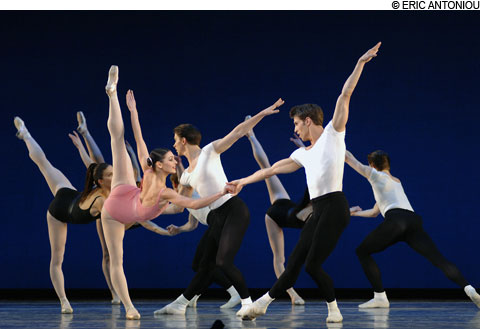
PLEASURE PRINCIPLE When it comes to Balanchine, there's nothing like the real thing — and Boston Ballet has benefited by its familiarity with Symphony in Three Movements. |
Boston Ballet's "Simply Sublime" (at
the Opera House through February 19) traverses 20th-century ballet's arc from Russian romance to a robust and confident neoclassicism. On opening night last Thursday, parts of that road were better paved than others.
Michel Fokine was already looking over his shoulder into the ambience of works like Giselle and La Bayadère when he created the plotless, Chopin-set Les Sylphides. This 1909 "ballet blanc" surrounds a male poet with a moonlit troupe of winged sylph maidens wearing long, drifting tutus. When it's done at its best — as Boston audiences experienced when the Kirov brought the ballet (the Russians still call it Chopiniana) on its 2003 Ballets Russes centennial program — Les Sylphides can shimmer mysteriously, like a daguerreotype. Thursday it was closer to paint by numbers.
Erica Cornejo has a gift for dancing Fokine. She brought the same bountiful, soft arms to Les Sylphides that I've seen her deploy as the dreamer in Spectre de la Rose. Her series of jete leaps crested like seafoam. Whitney Jensen skipped effortlessly through her variations as if moonlight had given way to exuberant sunshine. But Lorna Feijoo "listened" in the Prelude section, raising her hand to her temple with gloomy, "what's the point" vagueness. The posture and sloppy footwork of her poet, Nelson Madrigal, made his role seem irrelevant when it should anchor the women's configurations instead. Conductor Jonathan McFee in the orchestra pit knows better than to support the dancers by distorting tempos so drastically. He wasn't doing Chopin or Fokine any favors.
PHOTOS: Boston Ballet's Les Sylphides, by Eric Antoniou
Polyphonia by Christopher Wheeldon, a reprise from Boston Ballet's 2007 repertory, is a "leotard ballet" where the shards of Gyorgy Ligeti's piano music (played with panache by the wonderful Freda Locker) are translated into arrows and horns, and the legs of a ballerina (Lia Cirio) are manipulated like calipers. It's full of Balanchinian inheritance: the flexed wrists, the sitting-in-the-air lifts, and a range of moods from strict to tender to playful. Polyphonia shows off Boston Ballet's principals and soloists, especially the deft male duet of Joseph Gatti with Paulo Arrais, without demanding they oversell their taken-for-granted flexibility and élan.
There's no question Wheeldon's choreography, much of which was created for and with dancers Mr. B. trained, stands in heartfelt tribute to Balanchine. But whereas Balanchine style can be simulated, the real thing is nonpareil. Symphony in Three Movements had been the opening salvo of the New York City Ballet's Stravinsky Festival in 1972 and is set to music Stravinsky had composed for three different films. Boston Ballet danced it last year and, with familiarity, they raised their game.
Sixteen gamines with their flouncy ponytails rocking back and forth in front of a blue backdrop look like they're about to leap into the lanes of a swimming pool. The solo women — tiny Misa Kurunaga dancingwith special oomph to her kicks, Tiffany Hedman flirtatious, and Kathleen Breen Combes, flouncing like an uptown lady trailing a cigarette from a long holder— were delightful.
But the greatest pleasures of Symphony in Three Movements rest in Balanchine's surprising contrapuntal moves for the ensemble, the visual density that makes a stage a city, and a particularly American one at that. This road, cut by two émigré Russians, may start at a theater in Boston's Downtown Crossing, but it heads unswervingly toward New York.